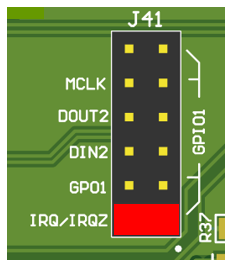SLAU903 October 2023
- 1
- Description
- Get Started
- Features
- Applications
- 6
- 1Evaluation Module Overview
- 2Hardware
-
3Software
- 3.1 Software Description
- 3.2 PurePath Console 3 Installation
- 3.3 TAx5x1x-Q1 EVM GUI
- 3.4 Configuration Examples
- 3.5 System Overview
- 4Hardware Design Files
- 5Additional Information
- 6References
2.5 GPIO1 Hardware Configurations
GPIO1 has many configuration options through J41 header, but only one setting is allowed at a time. GPIO1 can be configured for general purpose input output and Audio Serial Interface can be configured as either MCLK, DIN or DOUT in controller or target mode. This is shown in the figure below.
 Figure 2-20 GPIO1 Configuration
Figure 2-20 GPIO1 Configuration